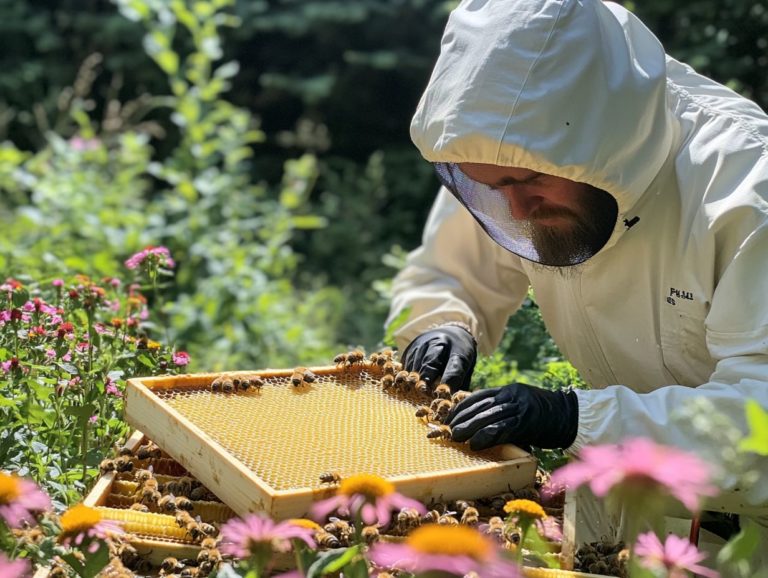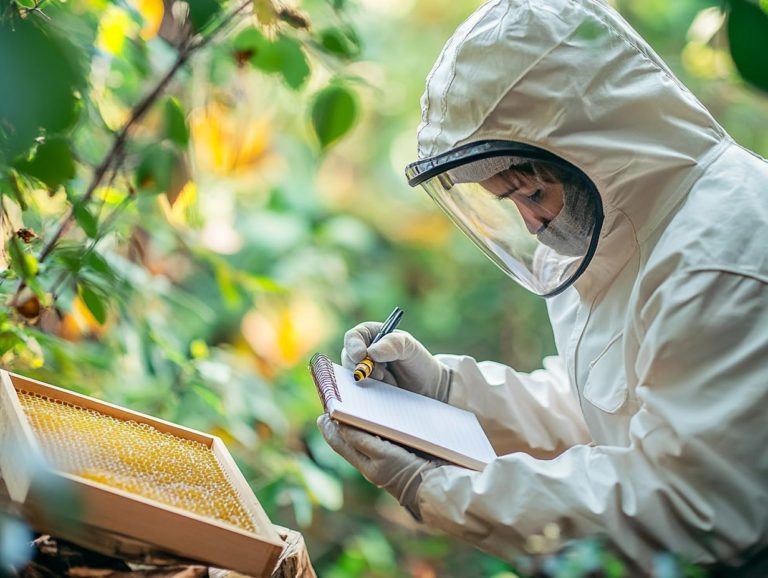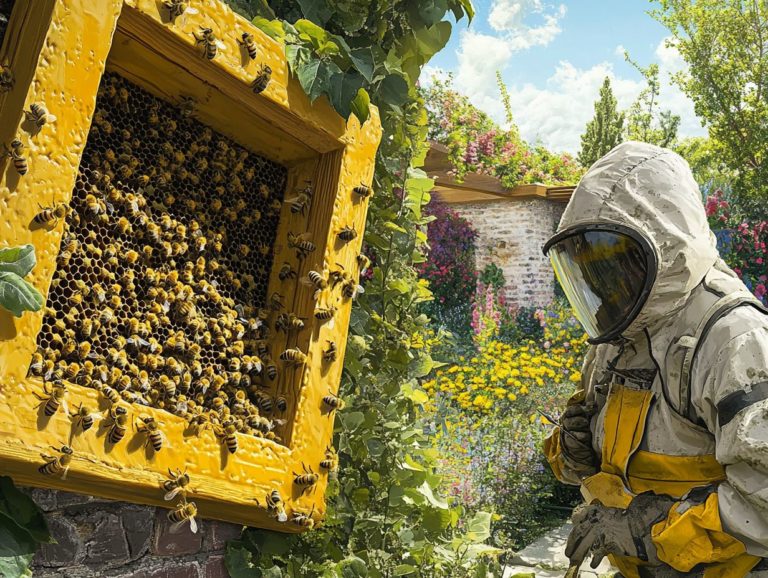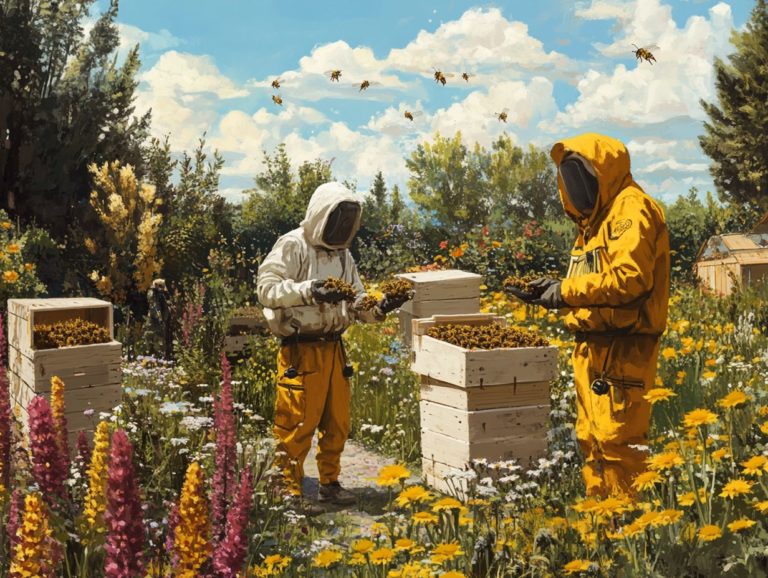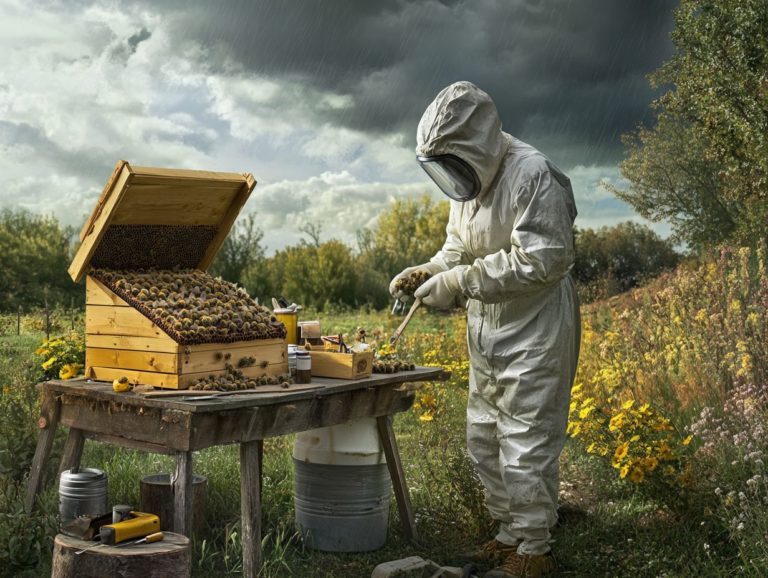The Impact of Pests on Hive Management
Effective hive management is essential for maintaining the health and productivity of your bee colonies, but it faces considerable threats from various pest species.
Explore now the various pests that threaten your hives: think mites, beetles, and wax moths. Understand how they can disrupt hive structure, diminish honey production, and facilitate the spread of diseases like American foulbrood.
Be equipped with practical strategies for identifying and preventing these pests, as neglecting pest management can lead to serious consequences.
Dive in with us to uncover the vital aspects of safeguarding your hives.
Contents
- Key Takeaways:
- The Importance of Hive Management
- What Are Pests in Beekeeping?
- How Do Pests Affect Hive Management?
- How to Identify and Prevent Pests in Beekeeping?
- What Are the Consequences of Not Managing Pests in Beekeeping?
- Frequently Asked Questions
- What is the impact of pests on hive management?
- What are common pests that can affect hive management?
- How do pests harm the hive and bees?
- Can pests be managed without using chemicals?
- What are the consequences of not managing pests in a hive?
- How can beekeepers prevent pest infestations in their hives?
Key Takeaways:
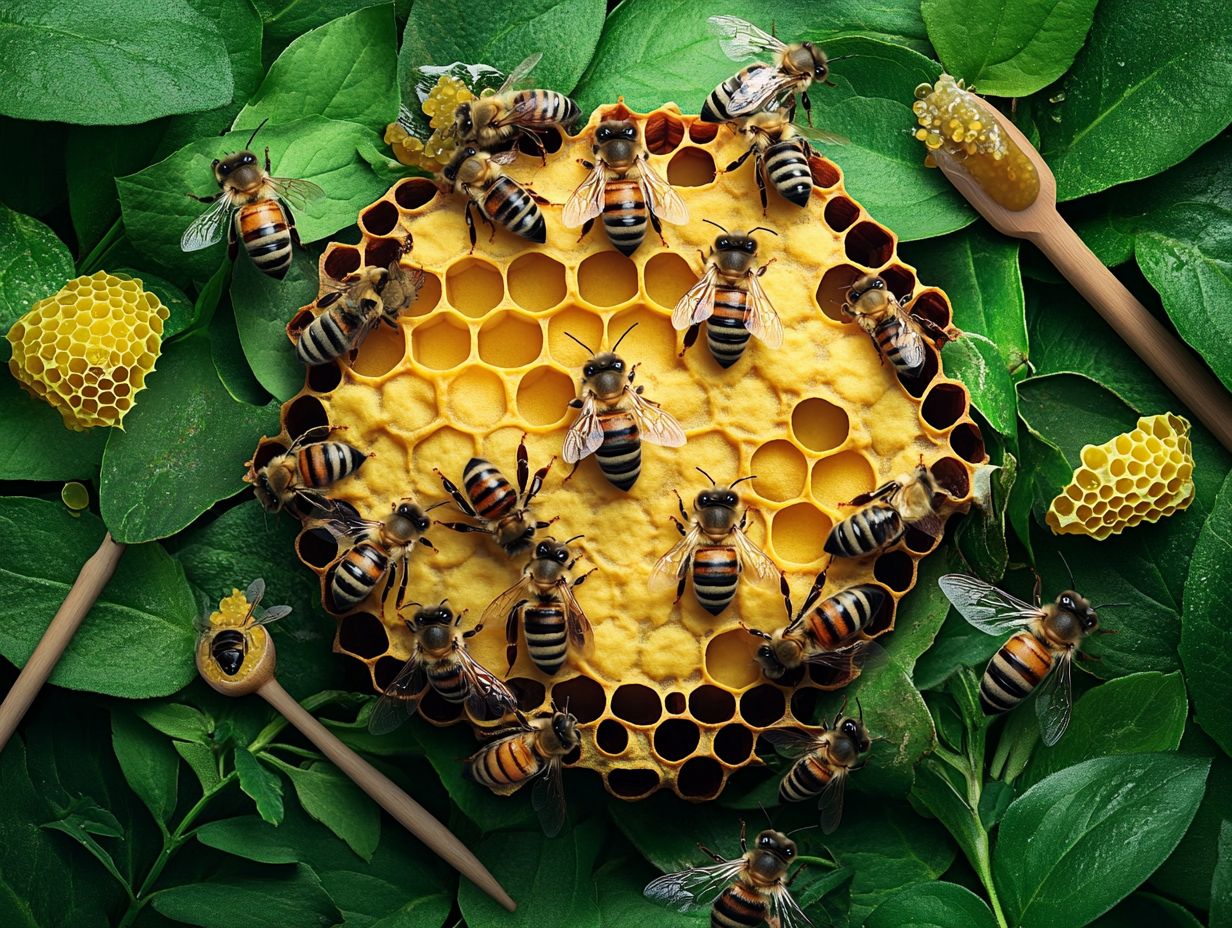
- Pests can devastate your hives be vigilant!
- Regular hive inspections and proper sanitation practices are essential for identifying and preventing pests in beekeeping.
- Failure to manage pests can lead to colony collapse and loss of income, impacting beneficial pollinators and the environment.
The Importance of Hive Management
Hive management is a pivotal component of successful beekeeping. It directly impacts both honey production and the overall health of your bee colonies.
To excel in this area, embrace effective hive management practices that incorporate a system to manage pests. This approach enables you to monitor pest populations and adopt sustainable pest management strategies, including chemical, mechanical, and natural methods to keep pests away.
This is essential not only for maintaining the economic viability of your beekeeping endeavor but also for protecting those invaluable pollinators and ensuring the longevity of your hives through proactive pest control.
By honing in on the biology of pests, understanding the level of pests that can harm your bees, and the point at which action needs to be taken, you can significantly mitigate pest damage and enhance the productivity of your hives.
With this knowledge, you’ll be well-equipped to foster a thriving beekeeping operation that benefits both you and the environment.
What Are Pests in Beekeeping?
In beekeeping, pests are the unwelcome guests that can wreak havoc on your honey bee colonies, impacting their health and productivity in significant ways.
Among these pests, the Varroa mite stands out as a formidable adversary, presenting a serious threat to honey bee populations. The small hive beetle also merits attention, as it damages the hive structure and induces stress within the colony, increasing vulnerability to diseases like American foulbrood.
Diseases like American foulbrood can destroy entire colonies. This highlights the need for effective pest recognition and management.
By understanding the biology and behavior of these intruders, you can implement successful pest management strategies, ensuring your hives remain healthy and thriving.
1. Mites
Mites, particularly the infamous Varroa mite, rank among the most devastating adversaries in the world of beekeeping. They infiltrate honey bee colonies, causing alarming population declines. These external parasites latch onto your honey bees, feasting on their bodily fluids and transmitting viruses that can severely compromise the health of the entire colony.
The detrimental effects of a Varroa infestation can be strikingly evident. You may experience diminished brood production, reduced honey yields, and, in the worst-case scenario, the complete collapse of your colonies if left unchecked. As a beekeeper, you hold a pivotal role in counteracting these impacts by establishing levels of mite infestation that determine when to take action. Consistent monitoring practices, such as evaluating mite levels through sugar rolls or alcohol washes, are essential for maintaining the vitality of your colonies.
You can tailor various control strategies to fit the unique conditions of your apiary, ensuring that your methods remain effective while minimizing any potential harm to both your bees and the surrounding environment. By implementing a comprehensive approach to deal with pests while protecting your bees, you not only tackle the immediate threats posed by the Varroa mite but also foster long-term resilience within your honey bee populations. Stay proactive protect your hive today!
2. Beetles
Beetles, particularly the small hive beetle, are notorious pests that can cause serious disruptions in your beekeeping activities. They damage hives and threaten honey production. When small hive beetles invade your colonies, they compromise honey quality and increase stress levels among your bees.
Monitoring their populations is essential for your success as a beekeeper! To effectively manage these pests, you should employ a combination of preventive and reactive control measures. This might involve implementing cultural practices, chemical control, and optimizing your hive management techniques to minimize the risk of infestations.
Understanding the life cycle of the small hive beetle is crucial for protecting your colonies from this invasive threat. Adult beetles typically lay their eggs within the hive, where the larvae develop by feeding on honey, pollen, and even bee larvae. This escalates the risk to hive health. Their tendency to burrow into wax and debris adds another layer of complexity to your hive maintenance efforts.
Conducting regular inspections, ensuring proper sanitation, and using traps can significantly help reduce beetle populations. By placing a premium on hive maintenance and implementing vigilant monitoring strategies, you can create an environment that is unfavorable for beetles. This will ultimately bolster the strength of your colonies and enhance honey yield. Don’t wait act now to safeguard your bees!
3. Wax Moths
Wax moths represent a significant threat to your hives, capable of inflicting considerable structural damage on honeycomb and stored honey. When their larvae feast on beeswax, they can weaken your hives, potentially leading to colony collapse if left unchecked.
To minimize the risk of pest damage from wax moths, it s essential to adopt proper hive management practices. Regular inspections, maintaining hygiene, and employing integrated pest management techniques are vital for keeping your hives clean and well-maintained, effectively preventing infestations.
Understanding the lifecycle of these pests is key to safeguarding your colonies. Wax moths progress through several stages from eggs to larvae, and finally to adult moths with the larvae being the most destructive. Their presence not only jeopardizes the structural integrity of your hive but also hampers honey production, as stressed bees tend to focus more on defense rather than foraging. Including genetic control measures can also be beneficial in mitigating their impact.
Staying organized with your hives and keeping an eye out for signs of infestation are crucial practices. Implementing effective sanitation methods, such as removing unused equipment and clearing out dead bees, helps cultivate an environment that is less inviting to wax moths. Take action today to protect your bees and ensure a thriving apiary!
4. Ants
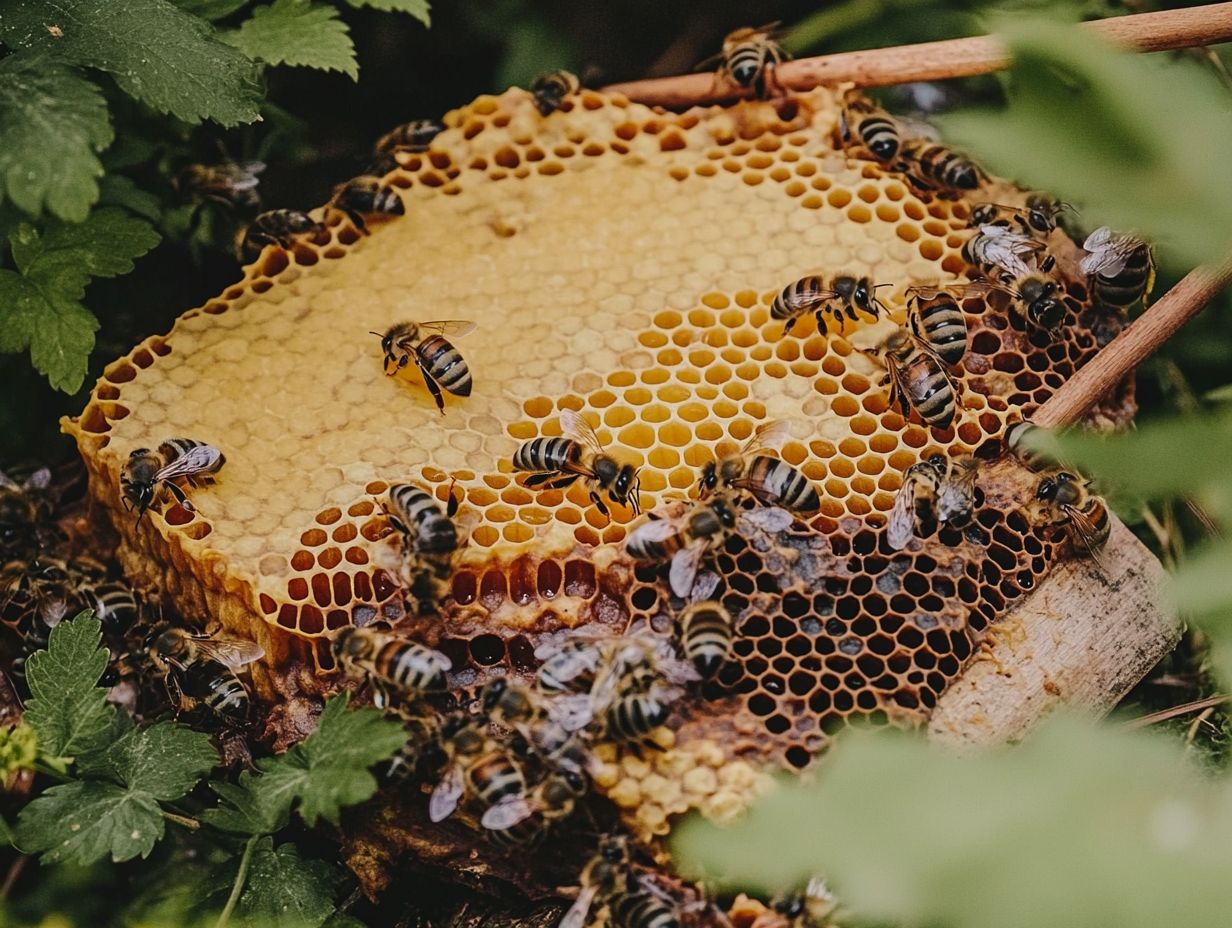
Ants, though often dismissed, can become quite the nuisance in your beekeeping endeavors. They may invade your hives in search of honey and other treasures, causing disturbances within the colony.
Some ant species can be aggressive, presenting a threat not only to your bees but also to your honey production. Managing ant populations is essential for effective hive management, so you should consider employing cultural practices and barriers to keep them at bay.
Certain species, like the Argentine ant and the carpenter ant, are particularly infamous for their intrusive behavior, often swarming around hives and competing for resources. Their presence can disrupt the foraging patterns of your bees, leading to stress within the colony and ultimately diminishing honey yields.
Aggressive encounters between ants and bees can result in injuries and disorientation among your bees, further throwing the hive s dynamics into chaos. You can tackle this issue by implementing strategies such as elevated hive stands, diatomaceous earth barriers, and keeping a close eye on ant activity around your hives.
Make your hives uninviting for ants by using natural repellents. This can significantly bolster your prevention efforts, helping to maintain the delicate balance necessary for a flourishing beekeeping operation.
How Do Pests Affect Hive Management?
Pests significantly impact hive management, leading to damage, reduced honey production, and the spread of diseases among honeybee populations. When pests like the Varroa mite and small hive beetle invade, they increase stress on colonies, making them more vulnerable to diseases such as American foulbrood.
You must act quickly! Effective strategies and teamwork are crucial to tackle these pest threats head-on. Ineffective hive management due to pest infestations can trigger colony collapse, posing a grave threat to the sustainability of the beekeeping industry and the essential pollination services that honeybees provide.
The USDA and other organizations have developed pest eradication programs to help mitigate these risks.
1. Damage to Hive Structure
Pests can wreak havoc on the structure of your hives, weakening their integrity and jeopardizing the health of your honeybee colonies. Infestations from pests like the small hive beetle can create disorganized environments within the hive, making it challenging for your bees to maintain their living and working spaces.
This damage disrupts hive operations and escalates pest management challenges, requiring you to take proactive steps to strengthen hive structures and reduce their vulnerability to pests. Understanding how pests live and reproduce can aid in these efforts.
Other pests, such as wax moths and Varroa mites, present serious threats as well. Wax moth larvae can munch through comb and disrupt larval development, while Varroa mites undermine bee populations by transmitting diseases and causing stress.
Effective pest control strategies are essential to manage these threats. To effectively combat these issues, you should regularly monitor your hives for signs of infestations and employ preventative measures, such as using traps or nurturing robust bee colonies that can better defend against pests.
Employing a method that uses various techniques to control pests is also recommended. By adopting these strategies, you can protect hive health and enhance resilience against pest-induced damage, ensuring sustainable honey production and the longevity of your colonies.
2. Decreased Honey Production
The increased pest population and subsequent damage can significantly impact honey production, a crucial aspect of the beekeeping industry.
The presence of pests in beekeeping can lead to a notable decrease in honey production. This directly affects the economic viability of your beekeeping operation.
Pests like the Varroa mite and wax moth can wreak havoc on honey bee foraging and hive dynamics, ultimately resulting in lower honey yields. It’s essential for you to understand the financial impact levels associated with pest infestations and adopt effective pest control strategies to mitigate these losses.
For example, research indicates that an unchecked Varroa mite population can slash honey yields by as much as 60%. This financial hit is something you simply cannot afford. Such reductions impact not only your immediate profits but also your long-term business sustainability.
Lower honey production may force you to exit the market or hike your prices, making your product less competitive. Understanding financial impact levels and establishing treatment thresholds for pest control can prevent such financial losses.
Act now by maintaining hive health with regular monitoring and employing integrated pest management techniques. This will ensure a steady flow of honey, safeguarding the economic future of your beekeeping endeavors in this vital agricultural sector. It is also important to consider pesticide applications judiciously to avoid pesticide resistance.
3. Spread of Diseases
Pests represent not only a direct threat to honey bees but also serve as carriers for diseases like American foulbrood, putting your hive’s health and productivity at risk. When pests such as the Varroa mite invade your colonies, they weaken the bees. This makes them more vulnerable to a variety of pathogens and complicates your hive management efforts significantly.
Effective pest management is essential for preventing diseases and keeping honey bee populations healthy. Adopting pest management strategies can also prevent disease spread.
The interplay between pests and disease transmission is a major concern for beekeepers like yourself. Certain infestations can intensify the impact of diseases. Take the small hive beetle, for example; its presence has been linked to the spread of harmful bacteria and invasive species that can wipe out entire colonies.
To mitigate these risks, consider these integrated pest management strategies:
- Regular monitoring
- Sanitation measures
- The introduction of natural predators
- Biological control methods
By making these practices a priority, you can significantly reduce the risk of pest-related diseases, ensuring the vitality and productivity of your hives.
How to Identify and Prevent Pests in Beekeeping?
Identifying and preventing pest infestations in beekeeping is essential for maintaining vibrant colonies and maximizing honey production.
Regular hive inspections serve as the foundation of effective pest management. This allows you to detect infestations early and implement suitable strategies to address them. Understanding pest thresholds and employing monitoring practices can help manage pest damage at a sustainable level.
By employing monitoring practices such as tracking pest populations and evaluating hive conditions you can make informed decisions about pest management options. This ensures that you take proactive measures to protect your hives from potential threats.
Start your pest management journey today for a thriving apiary!
1. Regular Hive Inspections

Regular hive inspections are an essential practice for you as a beekeeper. They act as a critical tool for monitoring pests and ensuring the overall health of your honey bee colonies.
By conducting these systematic checks, you can spot early signs of pest infestations, assess the condition of your hives, and implement timely pest management strategies when necessary. Acting now with this proactive approach is crucial for your bees’ survival against threats like the Varroa mite and small hive beetle.
Utilizing a monitoring system can further enhance your ability to detect and manage pests effectively. Beyond pest identification, thorough inspections enable you to monitor for signs of diseases and check the queen’s health.
It’s also important to evaluate the availability of food sources within the hive. By paying attention to bee behavior and environmental conditions, you can uncover deeper insights into the well-being of your colonies.
Keeping a log of your observations allows you to track changes over time, leading to more informed choices regarding your pest management strategies. Establishing a comprehensive inspection routine not only protects the health of your hive but also enhances your understanding of the intricate dynamics within the ecosystem.
This ultimately supports sustainable beekeeping practices that benefit both you and your bees.
2. Proper Sanitation Practices
Proper sanitation practices are essential for effective pest prevention in beekeeping. They ensure your hives remain clean and healthy.
By removing unwanted materials, debris, and old combs, you can significantly minimize the risk of attracting pests and lower the chances of infestations. Integrating these sanitation measures into your overall hive management strategy is crucial for fostering robust honey bee colonies.
Regular inspections are critical for catching potential threats early, allowing for swift interventions. It s vital to keep your tools and equipment clean to avoid cross-contamination between hives, as diseases can spread rapidly through contaminated surfaces.
Maintaining a tidy apiary, free from spilled honey or discarded equipment, will help deter rodents and other pests that could jeopardize the health of your hives. Ultimately, by prioritizing cleanliness and adopting thorough sanitation protocols, you can greatly enhance the resilience of your honey bee populations against various pests.
This approach will substantially contribute to the sustainability of the beekeeping industry.
3. Use of Pest Control Measures
Utilizing effective pest control measures is crucial for managing pest populations in your beekeeping endeavors. This encompasses a variety of strategies, including Integrated Pest Management (IPM), which is a method that combines different strategies to control pests, and chemical insecticides.
You have a range of pest management options at your disposal, including biological control methods that harness beneficial organisms to combat pests. This minimizes your reliance on chemical solutions.
By implementing these pest control measures effectively, you not only safeguard your hives from potential damage but also contribute to the sustainability of honey bee populations and their invaluable role as pollinators.
Many successful beekeepers have turned to IPM techniques that blend biological methods like introducing nematodes to specifically target wax moth larvae with selective chemical treatments when the situation calls for it.
For instance, a fascinating case study from California showcased a beekeeper who adopted a targeted strategy, reporting an impressive 80% reduction in varroa mite populations after integrating essential oils into their management approach.
While chemical treatments can offer immediate relief, it’s important to recognize the potential risks of pesticide resistance and the adverse impact on beneficial insects if used carelessly. This ongoing balancing act between chemical and biological controls underscores the necessity for you, as a beekeeper, to stay well-informed about your options.
This knowledge is key to ensuring the health and vitality of your colonies. Additionally, utilizing pest management options such as biological control and integrated control methods can create a more balanced approach.
What Are the Consequences of Not Managing Pests in Beekeeping?
Failure to manage pests effectively can lead to a devastating pest-infested hive, causing significant economic injury and jeopardizing your entire beekeeping operation.
Neglecting pest management can lead to the collapse of your colonies and loss of income. Healthy bee populations are crucial because they support agricultural productivity.
When you don t implement effective pest control strategies, infestations can wreak havoc on your bee populations. This leads to reduced honey production and financial setbacks.
Moreover, the decline of honey bee colonies threatens local ecosystems, as these invaluable pollinators are essential for both pollination and agricultural productivity.
Taking proactive measures in pest management is not just a necessity; it is a responsibility that safeguards your livelihood and the environment.
1. Colony Collapse
Colony collapse is one of the most concerning consequences of inadequate pest management, particularly regarding the Varroa mite and other detrimental pest species that threaten bee populations.
This phenomenon, marked by the sudden disappearance of adult bees, can result in the loss of entire hives if not addressed promptly and effectively. Understanding the factors behind colony collapse is vital to saving your hives!
It s essential to comprehend the factors contributing to colony collapse, especially pest management failures. This knowledge is vital for protecting your hives and sustaining healthy honey bee populations.
Understanding pest biology and pest density can help you manage your colonies better. Several factors can intensify the challenges you face, including environmental stressors, nutrient deficiencies, and the rising use of pesticides.
Thus, adopting a holistic approach to pest management is imperative. This combined approach uses different methods to control pests effectively.
Implementing integrated pest management strategies such as conducting regular hive inspections, utilizing resistant bee strains, and fostering an environment that minimizes pest exposure can significantly mitigate the impact of these invaders.
Understanding the pest thresholds and treatment thresholds is also important. Stay informed about the latest developments in pest control methods and engage with local beekeeping communities.
By sharing insights and experiences, you can enhance the resilience of your colonies against the persistent threat of colony collapse. Utilizing monitoring systems and understanding pest management options are key to effective control.
2. Loss of Income
The loss of income is a significant consequence you may face when pests are not managed properly. This can lead to decreased honey production and diminished market viability.
Unchecked pest populations can severely compromise hive health and productivity, resulting in financial losses that threaten the economic stability of your beekeeping operations.
Implementing effective pest management strategies, including genetic control and mechanical control, is essential to safeguard against these losses. This ensures long-term viability in the beekeeping industry.
Consider the impact of invasive pests like varroa mites and small hive beetles. They can lead to colony collapses, with some beekeepers reporting losses of up to 80% of their hives due to ineffective management practices.
This not only affects honey yields but can also incur additional expenses for hive replacement and medication, significantly straining your budget.
The resources spent on recovering from pest infestations could have been allocated to expanding your operations or enhancing product quality.
Therefore, understanding the economic implications and prioritizing proactive pest management including chemical control and biological control is crucial for maintaining your profitability and sustainability in beekeeping.
3. Negative Impact on Environment
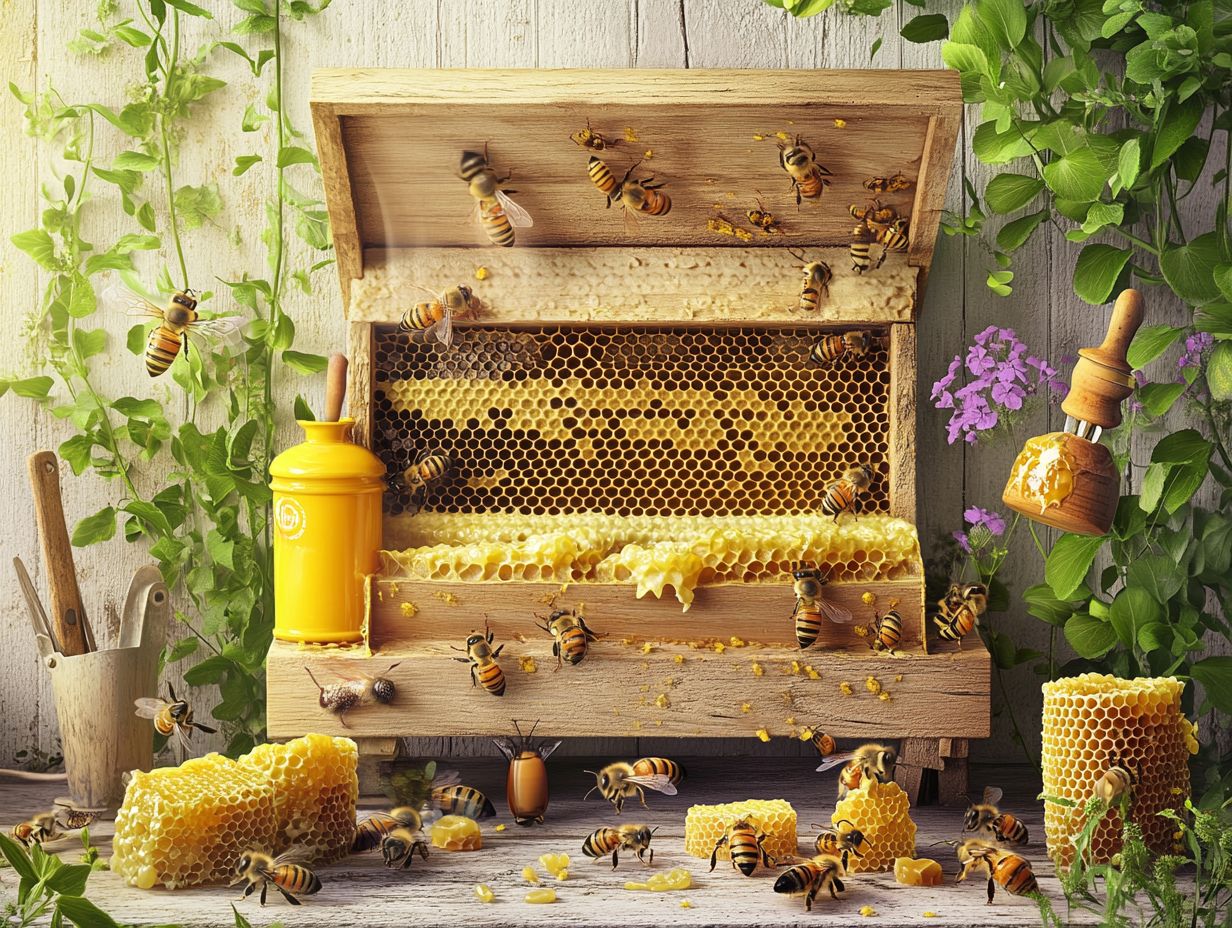
Neglecting pest management in your beekeeping endeavors not only jeopardizes the health of honey bees but also negatively impacts the environment, disrupting vital natural pollination processes. Honey bees play a crucial role as beneficial pollinators for numerous crops and wild plants. Their decline due to pest infestations can lead to a significant reduction in biodiversity and compromised ecosystems. Therefore, effective pest management is essential not just for the sustainability of honey bee populations but also for preserving ecological balance and enhancing agricultural productivity.
When honey bee populations decline, the repercussions extend far beyond the confines of the beehive. Pollination is vital for the reproduction of many plant species, many of which serve as food sources for a variety of animals. As these plants dwindle in number, a cascading effect can unfold, impacting the broader food web. The decrease in honey bees may also increase reliance on synthetic pesticides, which further aggravates environmental issues and endangers other beneficial insects. Effective pest control strategies can help mitigate these risks.
Thus, beekeepers must embrace responsible pest management to protect our vital ecosystems. Your commitment to these practices, including monitoring and cultural practices, can make a significant difference in both the health of your bees and the environment at large.
Frequently Asked Questions
What is the impact of pests on hive management?
Pests can have a significant negative impact on hive management as they can damage the hive and harm the bees. This results in reduced honey production and weaker colonies. Monitoring systems and understanding how pest numbers change over time are key to preventing these issues.
What are common pests that can affect hive management?
Common pests that can affect hive management include varroa mites, wax moths, small hive beetles, and ants. Invasive species like American foulbrood can also pose significant threats.
How do pests harm the hive and bees?
Pests harm the hive and bees in various ways. They can damage the hive structure, consume honey and pollen reserves, spread diseases, and weaken the bees’ immune system. Understanding pest biology and the economic injury level (the point at which pest damage outweighs control costs) can help in developing effective control measures.
Can pests be managed without using chemicals?
Yes, there are various non-chemical methods of pest management available. These include using screened bottom boards, reducing hive entrances, and employing natural predators like birds and mites. Biological control methods and genetic control strategies are also effective options.
What are the consequences of not managing pests in a hive?
If pests are not managed promptly, they can wreak havoc on hives, leading to colony collapse and devastating losses for beekeepers. This can also result in economic losses and impact the economic viability of their operations.
How can beekeepers prevent pest infestations in their hives?
Beekeepers can prevent pest infestations by regularly inspecting their hives and keeping the area around the hives clean. Using proper storage methods for equipment and effective pest management techniques is also crucial. They can consider using resistant bee stocks and rotating hive locations to minimize pest impact. Engaging in cooperative programs and adhering to integrated control practices can further bolster defenses against pests.

